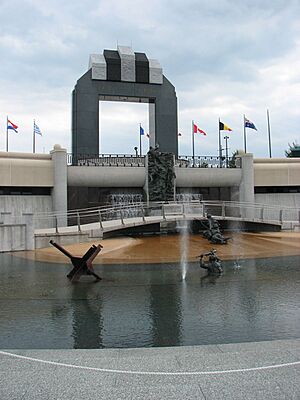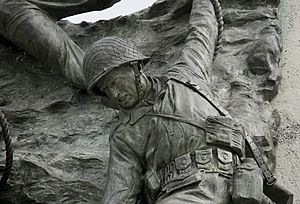National D-Day Memorial facts for kids
The National D-Day Memorial is a war memorial found in Bedford, Virginia. It is the official memorial for American soldiers who took part in D-Day. However, it also honors all Allied forces. These brave soldiers fought in the D-Day invasion of Normandy, France, on June 6, 1944, during World War II.
The memorial covers more than 50 acres (about 200,000 square meters). It sits near the Blue Ridge Mountains in Virginia, looking over the town of Bedford. The memorial officially opened on June 6, 2001. About 15,000 people attended, including then-President George W. Bush. Around 60,000 people visit the memorial each year.
Why Bedford? The Story of the "Bedford Boys"
The town of Bedford was chosen for the memorial because of its special connection to D-Day. Thirty-four soldiers from the Virginia National Guard in Bedford were part of the D-Day invasion. Sadly, nineteen of them died on the very first day. Four more died later during the Normandy campaign.
This meant that Bedford lost more soldiers, compared to its size, than any other American town during the D-Day invasion. Because of these great losses, the United States Congress decided to build the national D-Day memorial in Bedford.
Among the "Bedford Boys" were three sets of brothers:
- Twins Roy and Ray Stevens: Ray was killed during the landing, but Roy survived.
- Clyde and Jack Powers: Jack was killed, and Clyde was wounded but survived.
- Bedford and Raymond Hoback: Both brothers were killed.
The story of the Bedford soldiers was told in a popular book called The Bedford Boys by Alex Kershaw. Their bravery also helped inspire the movie Saving Private Ryan. The movie's director, Steven Spielberg, helped fund the memorial. He even helped create the Arnold M. Spielberg Theater there, named after his father, who was a World War II veteran.
Building the Memorial: A Special Design
It took about seven years to plan and build the memorial. It cost around $25 million to complete. In 1994, the town of Bedford gave 11 acres (about 45,000 square meters) of land for the memorial. More land was bought, making the total size over 50 acres.
The memorial is designed as a journey through three main areas, showing the timeline of the D-Day invasion.
- Reynolds Garden: This first area represents the planning and preparation for the invasion. It is shaped like the combat patch of the Supreme Headquarters Allied Expeditionary Force, which was the main Allied command.
- Gray Plaza: This middle section shows the actual landing and fighting. It has an "invasion pool" with obstacles in the water. There are also sculptures of soldiers struggling to get ashore. You can see a model of the Higgins boat used to carry troops. Water jets in the pool spray up, making sounds like gunfire. The names of all American soldiers who died in the invasion are listed on one wall. The names of other Allied soldiers who died are on another wall. This shows that all soldiers were part of one team, just as General Dwight D. Eisenhower wanted.
- Estes Plaza: This top area celebrates the victory. It features the Overlord Arch and the flags of the twelve Allied nations that fought in the Allied Expeditionary Force. The Overlord Arch stands 44 feet, 6 inches (about 13.5 meters) tall. This height includes the date of the invasion: June 6, 1944. "Operation Overlord" was the code name for the entire invasion. "Operation Neptune" was the code name for getting the troops across the English Channel.
Visiting the Memorial
The National D-Day Memorial is open every day, Monday through Sunday, from 10:00 AM to 5:00 PM. During January, February, and part of March, the invasion pool is drained for maintenance.
Besides its permanent displays, the memorial hosts special events throughout the year. These events help people remember World War II. Past events have included weekends with World War II re-enactors. The memorial also holds annual events for Memorial Day, Veterans Day, and D-Day.



